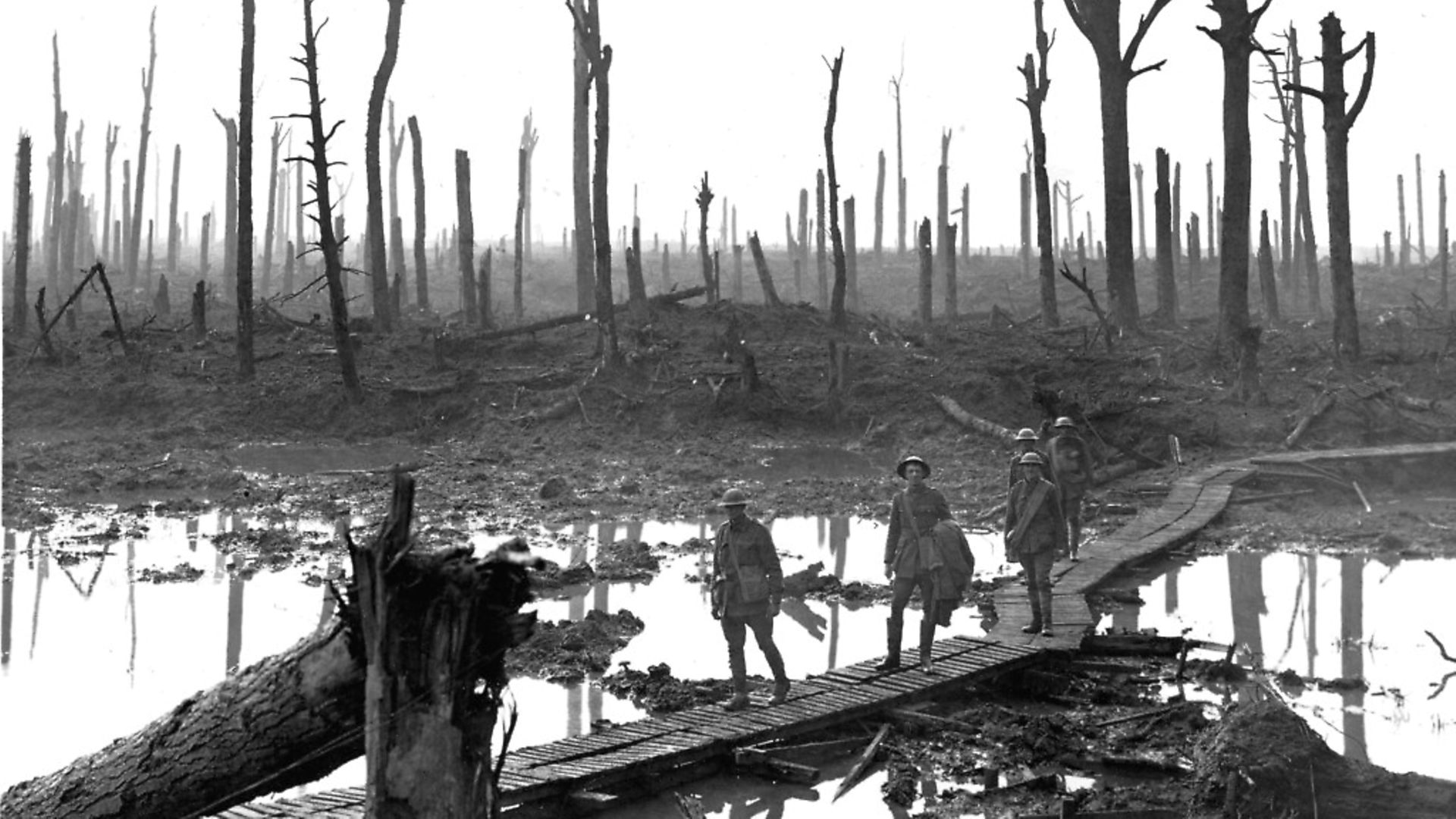
One hundred years ago, on July 31 1917, saw the start of the slaughter in that hell they called Passchendaele. Here’s why the battle still exerts such a hold on the national psyche…
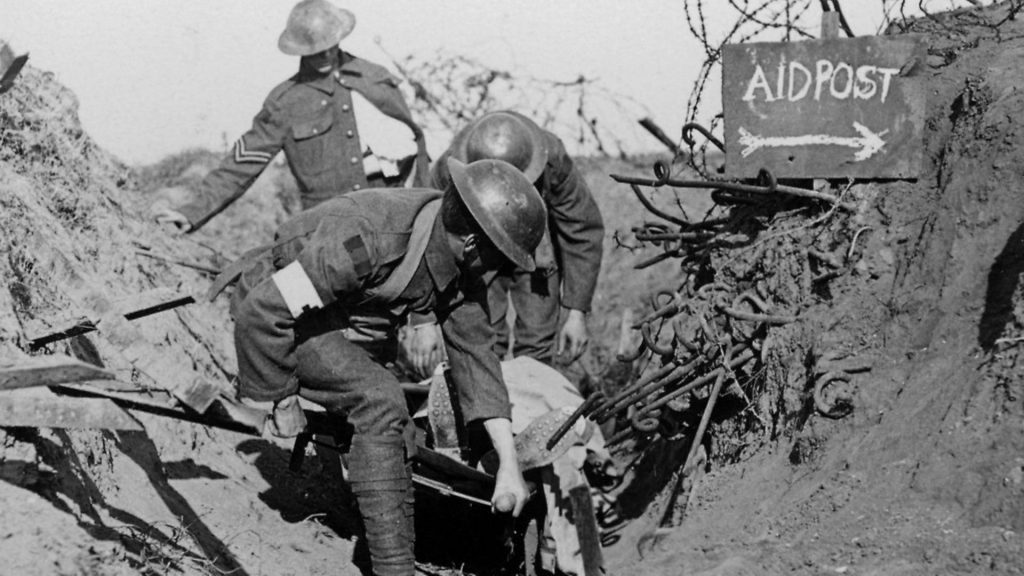
Passchendaele. The name resonates down through the past 100 years of British history. It’s a name that has come to mean a relentlessly grim battlefield of mud and blood in the Belgian province of West Flanders, as well as a deathly drain of manpower from the British Empire, Belgium, Germany and France. Even though Passchendaele was just one battle for a village in what was officially known as the Third Battle of Ypres, it is this name that can still make us shudder a century on.
Views of its usefulness (or otherwise) emerged quite swiftly after the end of the conflict. In the edition dealing with 1917 – part of the five-volume A Popular History of the Great War – published in the 1920s, the chapter on Passchendale ended with these words: ‘Whether the advantages gained from pinning large German forces to the Ypres salient outweighed the costliness and apparent uselessness of these operations will probably always remain a subject for controversy.’
When his memoirs were published, in 1938, David Lloyd George – who had been prime minister at the time of the battle – was more decisive in his analysis. ‘Passchendaele was indeed one of the greatest disasters of the war,’ he wrote. ‘No soldier of any intelligence now defends this senseless campaign.’
Yet his declaration has not necessarily stood the test of time. There are still voices who will make the case for this campaign. Nick Lloyd, albeit not a soldier, is a military historian of significant intelligence. In his recently published and well-acclaimed Passchendaele A New History, he argues – while recognising the horror of the event – that the campaign saw the Allies come tantalisingly close to breaking German morale on the Western Front. A century on, Passchendaele still has the power to encourage debate.
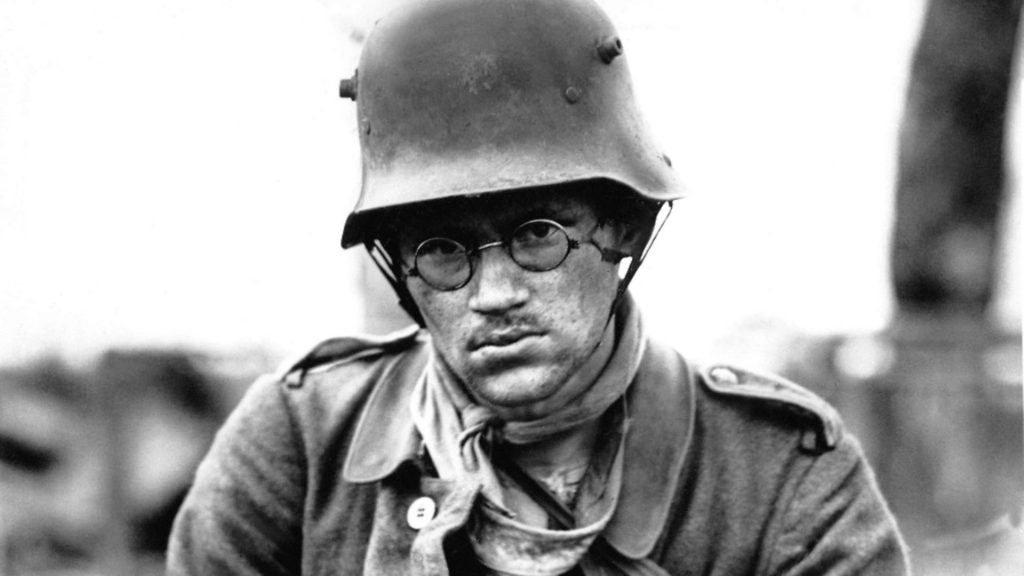
Although it is most associated with the mud that came a little later, the battle actually started at the height of the summer – exactly 100 years ago this week. At dawn on July 31, 1917, British forces assembled in the Ypres salient went over the top. The salient was an area of the British front which protruded into German-held territory, leaving it surrounded on three sides by the enemy, and therefore highly vulnerable. It had been formed in the fighting of the first weeks of the conflict and had already been the scene of much carnage, as both sides had fought to break the deadlock, by the time the Third Battle of Ypres, the latest attempt, started.
The campaign was launched a year and a month after the Somme offensive, further south on the Western Front. The ambitious aim was not just to strengthen the lines around the salient, but – once that was achieved – to break right through to the Belgian coast and neutralise the German U-boats operating from there. This determination had taken on added urgency after Germany resumed unrestricted submarine warfare on earlier in 1917. Following the British morale-boosting victory at nearby Messines in June 1917, Field Marshal Sir Douglas Haig calculated that German morale was low and that there was every chance for a decisive fight.
Nevertheless, Flanders was a controversial choice for an offensive. Lloyd George did not support the plan (hence his freedom to unequivocally condemn it in his memoirs), but in the absence of any other credible Allied plan to take the fight to the enemy, it went ahead – though Haig did not receive approval until six days before the attack.
By the time the battle drew to an anti-climactic close on November 10, an estimated half a million men from both sides had been killed or injured, and the Allies, despite some modest gains, were as far from the Belgian coast as they had been when they started.
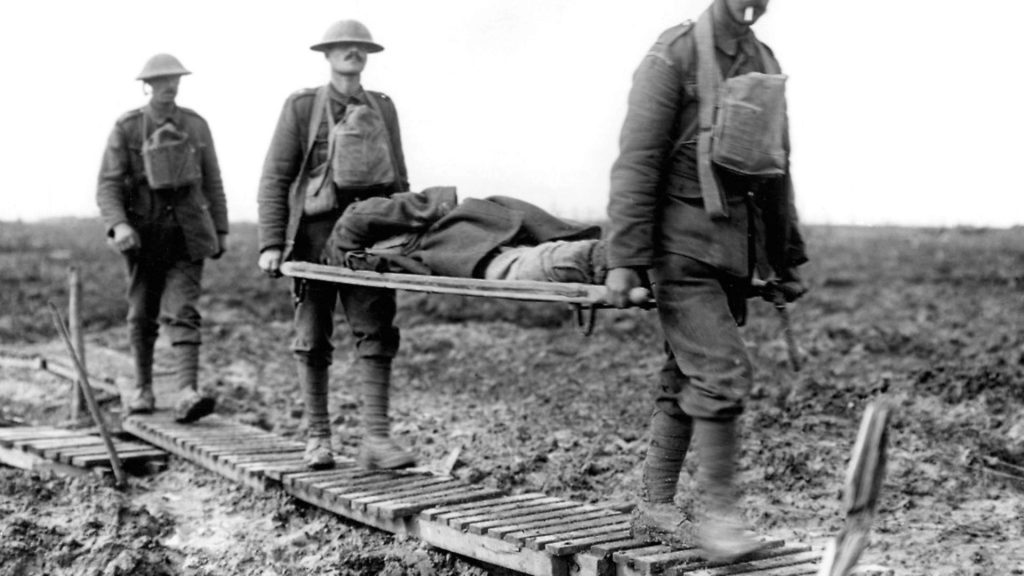
It would be wrong to characterise it as a repeat of the Somme. Lessons had been learned from that offensive. Troops were better trained to take on the machine-gun posts in pillboxes and fortified farmhouses that peppered the German lines, for instance. Yet ultimately this was another battle where advance was measured in metres and men and mules. And this time it was fought through flooded fields. There are accounts of tanks being swallowed up in their entirety. This malodorous marsh, where many of the dead vanished from sight and are still being uncovered, was the result of heavy rains (the heaviest for several decades) coupled with the destruction of the area’s drainage system over the previous three years of war. This was as bad as warfare can be, short of a nuclear exchange or large scale bombing. One veteran of Passchendaele, Rifleman GE Winterbourne, quoted in Lyn MacDonald’s magisterial collection of eye-witness reports, They Called It Passchendaele, gave an idea of the hellish conditions: ‘We were going through all this awful ground that was just lakes of shell-holes filled up with water… In a lull in the shelling we heard cries, and there was a poor chap about fifty or sixty yards away. He was absolutely up to his arms in it, and he’d been there for four days and nights — ever since the last attack — and he was still alive, clinging on to the root of a tree in the side of this shell-hole full of liquid mud.’
Winterbourne went onto describe how an officer and three men tried to get the man out, but completely failed. It would be another 24 hours before this poor soul was rescued. At least he was rescued, many others weren’t.
The enduring controversy of Passchendaele is why Haig continued to push his army deeper into the morass, when the realities became clear, rather than call an earlier halt. The disappointing gains and the immense butcher’s bill made this one of a series of low points of 1917 for the Allies, a year which also saw the Russian Revolution, French army mutinies, the failed Nivelle Offensive and the Italian collapse at Caporetto (a defeat which effectively ended the Battle of Passchendaele, with British and French resources diverted to help their ailing southern ally).
Yet 1917 was also, in some ways, the year the war turned decisively in favour of the Allies. The entry of the US into the war in April (even if American forces were not to follow in numbers until later) effectively ensured Germany’s ultimate defeat. The Royal Navy’s blockade of German ports was also starting to hit the civilian population hard, which was starting to wonder whether the war was worth it. And – it should not be overlooked – the colossal losses suffered by the German army at Passchendaele were having a similarly decisive, attritional impact. (It was a cold calculation of the time that Germany could ‘afford’ casualties far less than the Allies.)
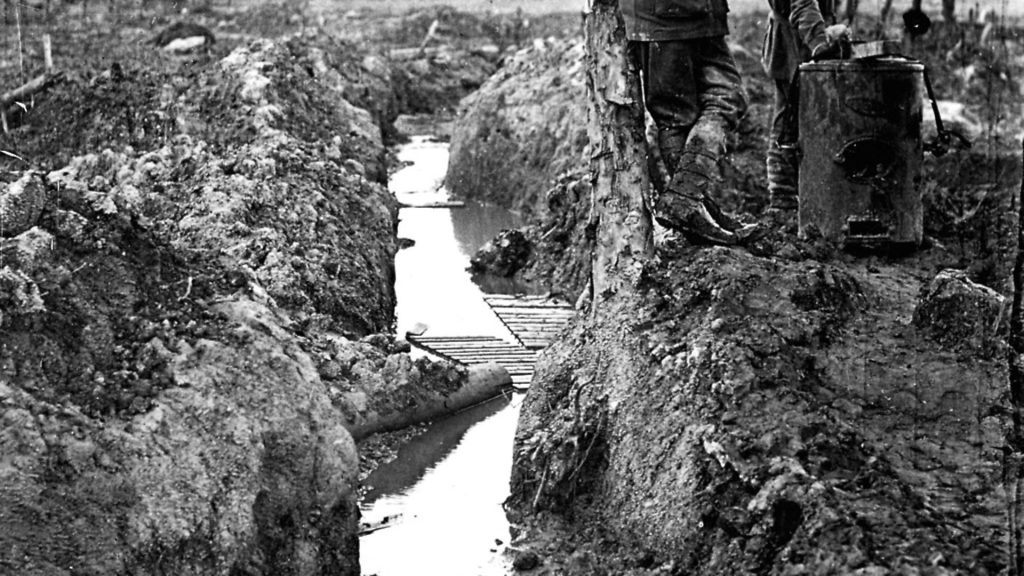
The Battle of Passchendaele – the third battle of Ypres, Belgium – Troops next to the muddy trenches
Fought between July and November 1917 heavy artillery craters and unseasonly heavy rain turned the battlefield into an expanse of deep mud. – Credit: Topham Picturepoint/Press Association Images
Nothing of this benefit of hindsight was available to those men slogging their way through the Flanders mud, of course.
A century, with Europe seemingly entering a new era of unsettled political turbulence and occasional loose talk of new wars (Brexiteers who accused Remainers of being melodramatic for pointing out the risks of Brexit to continental security lost that argument when Lord Howard started sabre-rattling over Gibraltar), Passchendaele remains an important reminder of the distance the continent has come, in – in historical terms – relatively little time.
A visit now to the battlefield helps reinforce that point. The municipality of Zonnebeke (of which the village of Passchendaele is a part), was at the centre of some of the fiercest fighting in the Third Battle of Ypres and after the war it was completely destroyed. But people moved back here and rebuilt their lives in the 1920s. Now it’s a quiet and reflective area, where agriculture and presumably battlefield tourism are the main employers.
The landscape has largely returned to its earlier appearance. But the scars of the war are still present in the remains of old trench systems which have survived. The most obvious reminder of the battle is three kilometres the north of Zonnebeke – Tyne Cot, the largest British Commonwealth cemetery in the world. Standing on the site of these former German lines, surrounded by row after row of white military tombstones, visitors can get an idea of its advantageous vantage point. There are panoramic views of the surrounding countryside while Ypres shimmers in the distance. Back in 1917, when this was perhaps one of the most dangerous spots on earth, German gunners would have had an unparalleled view of everything that moved.
Now it is bleak but beautiful and come the end of this month there will be events to remember, and descendants of those who died will arrive in their thousands. In the cemetery the amount of dead (11,965 are buried there, of whom 8,369 are unnamed) seems beyond calculation and beyond belief. The cemetery was established in October 1917, as the battle was still raging, after Australian and New Zealand forces captured the area. The distinctive name, though, is said to have come from Northumberland Fusiliers noting a resemblance between the many German concrete pill boxes on this site and typical Tyneside workers’ cottages.
It remains the most important physical symbol of the battle, and reminder of the part it played in the wider European (and then worldwide) conflict, which broke out twice in the first half of the twentieth century. For it was the memory of the slow stagnation of trench warfare, and the wastefulness of battles like Passchendaele, that, it could be argued, fuelled the pacifism of the 1930s, as well as the fascism and communism.
The French government developed a series of fortifications, the Maginot Line, having been shocked by the loss of so many of its men. Britain went broke and on the breadline and many of its intellectuals flirted with pacifism and communism. The USA shrunk into isolation, while many European countries wrapped their rhetoric in the cloak of populism and authoritarianism.
One great irony, often overlooked, is that start of the battle was actually a success, with objectives being achieved, though the death toll of 6,000 on just one day was a portent of things to come. However, you could also argue that there was a futility about the military actions that summer, a blindness amongst the high command that kept pushing soldiers to the limits of their endurance. The Germans had the high ground and the observation points. There was gas, howitzers, machine guns, as well as plenty of bravery. Furthermore, it is a bitter fact that by the spring of 1918 the Allies had to abandon the gains they had made the previous year and shrink the salient to a size that a general had suggested in 1915, a suggestion that had got him sacked.
There have been worse battles since, deadly duels on the Eastern front during the Second World War and the long slog from Normandy to Germany between June 1944 and May 1945 for instance. There have been worse generals than Haig, there have been weather conditions just as bad. However, Passchendaele still has that power, that totemic presence in our national psyche. It is a constant remainder – kept alive by the ongoing debate – of the inflexibility of the high command and well as the dogged stubbornness of the fighting man. It is also a reminder of a Europe that hopefully we will never see again.
Adrian Tierney-Jones is a journalist who writes about travel, history, drink and food.









